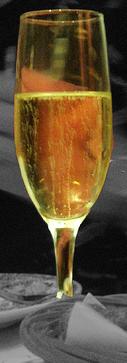
Back Cava AN Cava AST Denominació d'Origen Cava Catalan Cava Czech Кава CV Cava Danish Cava German Cava Spanish Cava (ardoa) Basque Cava Finnish

Cava (Catalan: [ˈkaβa]; pl.: caves) is a sparkling wine of denominación de origen (DO) status from Spain. It may be white (blanco) or rosé (rosado). The Macabeo, Parellada and Xarel·lo are the most popular and traditional grape varieties for producing cava.[1] Chardonnay and Malvasia are also permitted. Authorized red grapes are Garnacha tinta, Monastrell, Trepat, and Pinot Noir. Only wines produced in the traditional method may be labelled "cava"; those produced by other processes may only be called "sparkling wines" (vinos espumosos). About 95% of all cava is produced in the Penedès area in Catalonia, Spain, with the village of Sant Sadurní d'Anoia being home to many of the largest Catalan production houses.[2]: 144–145 The two major producers are Codorníu and Freixenet. Cava is also produced in other villages in the provinces of Girona, Lleida, Tarragona, and Barcelona in Catalonia, Zaragoza in Aragon, Badajoz in Extremadura, La Rioja, Araba/Álava in the Basque Country, Navarra and València in the Valencian Community.[3]
Marketing cava as "Spanish champagne" is no longer permitted under European Union law, since Champagne has a protected geographical status (PGS). Colloquially it is still called champán or champaña in Spanish or xampany in Catalan.[1] Today it is defined by law as a "quality sparkling wine produced in a designated region" (Vino Espumoso de Calidad Producido en una Región Determinada, VECPRD).[4]
The word champán in Spanish is not to be confused with achampañado, a colloquial term for the non-traditional sparkling wines. These achampañados wines are generally cheaper, are served by the bottle at bars or restaurants specializing in them and hence these establishments are called by the same name, i.e. achampañado. This is not cava, but it is a somewhat popular drink as well.
- ^ a b MacNeil, Karen (2001), The Wine Bible, Workman Publishing, pp. 454–460, ISBN 1-56305-434-5
- ^ Cite error: The named reference
Oxford 3rdwas invoked but never defined (see the help page). - ^ "RELACIÓN EMPRESAS ELABORADORAS DE CAVA - 2015" (PDF) (in Spanish). DO Cava. Retrieved 30 December 2015.
- ^ "PLIEGO DE CONDICIONES DENOMINACIÓN DE ORIGEN PROTEGIDA "CAVA" - 2011" (PDF) (in Spanish). Consejo Regulador Cava. Archived from the original (PDF) on 13 July 2019. Retrieved 29 June 2017.
© MMXXIII Rich X Search. We shall prevail. All rights reserved. Rich X Search